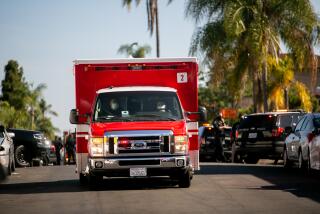Stroke symptoms? Ambulance = Brain
- Share via
When it comes to stroke, neurologists are fond of reminding us that “time equals brain.” What they mean is that, if you are experiencing any of the warning signs of stroke, the faster you get to the hospital, the more often physicians can take measures that limit the brain damage and long-term disability that stroke can cause.
But apparently, Americans are not getting that message -- and it may be costing us brain cells we can ill afford to lose. A “Research Letter” reported in the Journal of the American Medical Assn. this week reveals that in 2008, virtually no more Americans suffering the first signs of a stroke called 911 for ambulance transport than was the case in 1997. That’s despite active campaigns to get Americans to call 911 immediately if they suspect they or a loved one is having a stroke.
At last count, just over half -- 51% -- of patients determined to be having a stroke arrived for emergency medical care in an ambulance, wrote researchers from Weill Medical College in New York and UC San Francisco. In 1997, 49% did.
The effort to get stroke victims to call 911 and get help immediately took on special urgency in 1997, when a promising new clot-busting medication called tissue plasminogen activator, or tPA, was approved by the FDA to reduce the duration, intensity and damage of an ischemic stroke, in which a breakaway clot blocks or reduces blood flow to the brain. Physicians were taught that tPA would be effective only if used within the first three hours of the onset of a stroke, and that using it after that window had closed increased the risk of bleeding in the brain.
The introduction of tPA drove up the importance of recognizing a stroke’s warning signs and responding to them immediately by calling 911. Patients who do so almost always arrive more quickly at the hospital than if they call a friend or family member for a ride. And once there, they will be assessed more quickly and treatment with tPA can begin without delay.
Researchers have since found evidence that, even if given within a 4 1/2-hour window, tPA can help limit a stroke’s toll. And yet, last June, researchers reporting in the journal Stroke reported that fewer than 4% of those who have an ischemic stroke were getting tPA -- in large measure because patients were taking too long to get to the hospital.
Three little numbers, people! 9-1-1.
And in case you forgot, here are the symptoms that should prompt an immediate call (print them out here):
-- Sudden confusion, difficulty speaking or understanding others
-- Sudden numbness or weakness of the face, arms or legs, especially on one side of the body
-- Sudden trouble walking, dizziness or loss of balance or coordination
-- Trouble seeing out of one or both eyes
-- Sudden severe headache with no known cause







